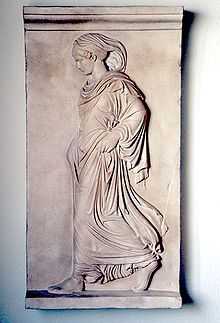Gradiva

The Gradiva, The woman who walks, has become a modern 20th century mythological figure. As she has sprung out of the imagination of a fictional character she may be considered unreal twice over. The fictional character in question is a young archaeologist, the protagonist of a novella by the German writer Wilhelm Jensen: Gradiva: Ein pompejanisches Phantasiestück (Delusion and Dream in Jensen's Gradiva 1903).[1] He is fascinated by a female figure in an antique bas-relief and gives her the name ‘Gradiva’ after Mars Gradivus, the Roman god of war walking into battle; later, not quite certain whether he is awake or dreaming he meets her in the ruins of Pompeii. Sigmund Freud famously analysed the actions and dreams of this young archaeologist in his study: Der Wahn und die Träume in W. Jensens Gradiva (1907).[2] Through this study Freud not only saved the novella from being forgotten but caused the Gradiva to become a modern mythical figure. The relief itself is not fictional but exists; it is now known by the name of „Gradiva“. The relief was described by Hauser (1903)[3] as a neo-Attic Roman bas-relief, probably after a Greek original from the 4th century BCE. It shows in its complete state the three Agraulides sisters Herse, Pandrosos und Aglaulos, deities of the dew. Hauser reconstructed the Agraulid-relief from fragments scattered over various museum collections. The Gradiva fragment is held in the collection of the Vatican Museum Chiaramonti, Rome,[4] its complement in the Uffizi Gallery, Florence.
Jensen’s novella and Freud’s analysis
The protagonist of Jensen’s novella, the young archaeologist Norbert Hanold, finds a relief with the figure of a young woman in a Roman antique collection. He is fascinated by her graceful walk and names her after Mars Gradivus, the Roman god of war walking into battle.
Freud's analysis is one of the first analyses of a literary work by him. Freud owned a copy of this relief, which hangs in his study (the room where he died) at 20 Maresfield Gardens, London — now the Freud Museum.
Adaptions
Salvador Dalí used the name "Gradiva" as a nickname for his wife, Gala Dalí. He used the figure of Gradiva in a number of his paintings, including Gradiva encuentra las ruinas de Antropomorphos (Gradiva finds the ruins of Antropomorphos). The figure Gradiva was used in other Surrealist paintings as well. Gradiva (Metamorphosis of Gradiva), 1939, by André Masson, explores the sexual iconography of the character. Gradiva, 'the woman who walks through walls' is the muse of Surrealism.[5]
In 1937 the Surrealist writer André Breton opened an art gallery on the Left Bank, 31 rue de Seine, christening it with the title: Gradiva. Marcel Duchamp designed it, giving its door the form of a double cast shadow.
The short artfilm Gradiva Sketch 1 (1978, camera: Bruno Nuytten) by the French cinéaste Raymonde Carasco was described as “a poetic construction about the fetishization of desire, one that seems to go against Freud's reading: the gracious movement of the maiden's foot is seen to be the object itself, not a mere referent, of male desire.”[6]
In 1986 the French surrealist writer and ethnographer Michel Leiris, together Jean Jamin, founded Gradhiva, a journal of anthropology; it is since 2005 published by the Musée du quai Branly (Paris, France).[7]
Notes
- ↑ English translation: Gradiva: A Pompeiian Fancy.
- ↑ in English: Delusion and Dream in Jensen's Gradiva.
- ↑ Friedrich Hauser: Disiecta membra neuattischer Reliefs. Jahreshefte des Österr. Archäol. Institutes Bd. VI (1903) 79-107.
- ↑ Cat. No. 1284
- ↑ Nadeau, Maurice, A History of Surrealism, (1965).
- ↑ Eye of Sound – UbuWeb Film
- ↑ The 'Gradhiva' Journal
External links
-
 Media related to Gradiva at Wikimedia Commons
Media related to Gradiva at Wikimedia Commons - Gradiva - Chiaramonti Museum, Rome
- Gradiva - Freud-Museum, London
- Freud Museum Exhibition Archive: Gradiva: The Cure Through Love
- Raymonde Carasco: Gradiva Sketch 1 (1978)